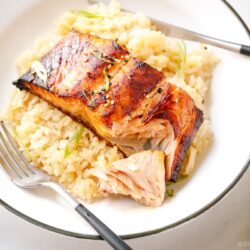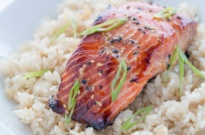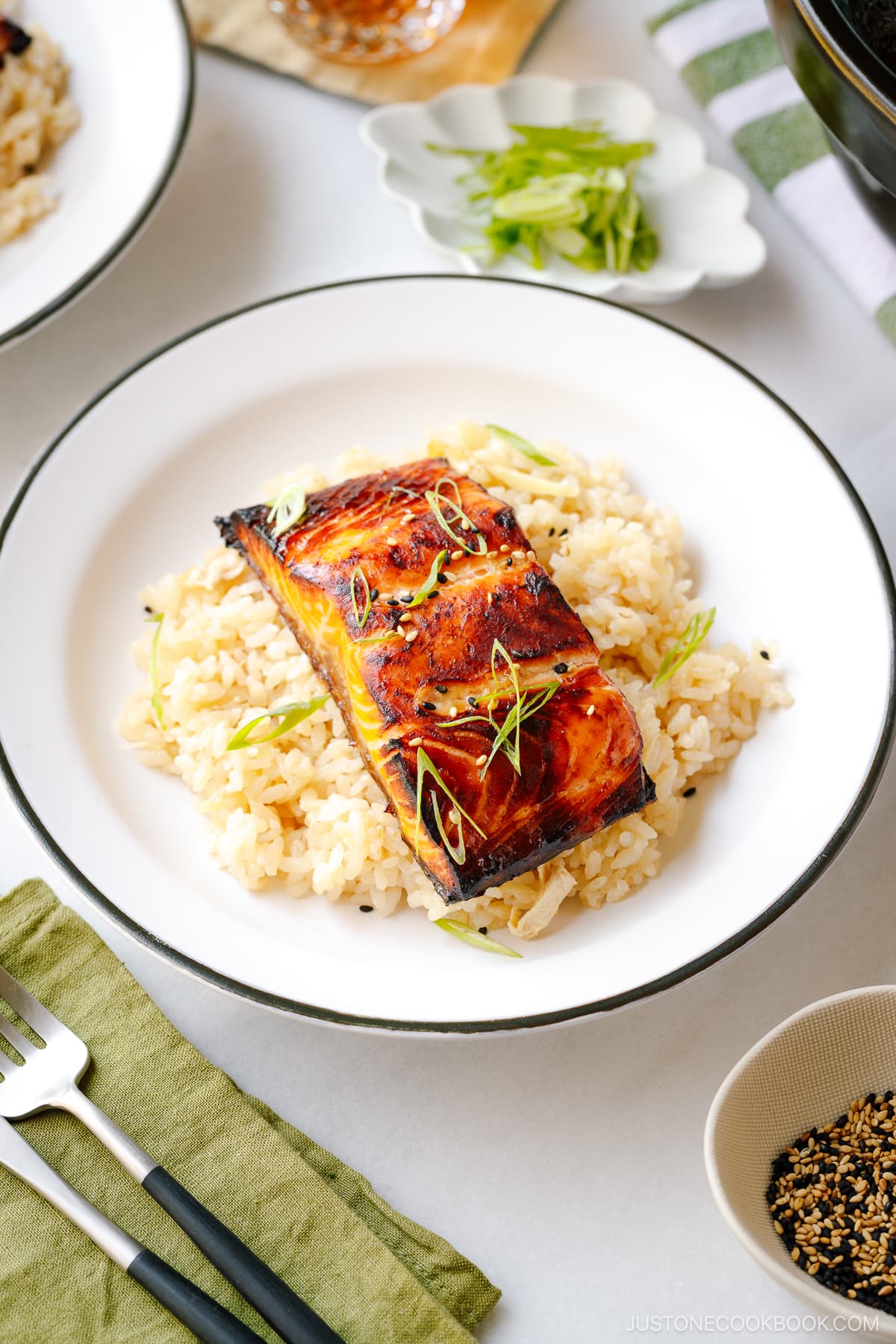
Salmon is truly one of the best choices of fish out there! I love that the fish is readily available, extremely versatile, and makes a healthy protein for any meal. Today, I’m excited to share one of my favorite go-to recipes that’s quick and full of savory flavor: Miso Salmon (味噌サーモン).
If you love salmon, try my Teriyaki Salmon, Japanese Salted Salmon, and Salmon in Foil recipes next!
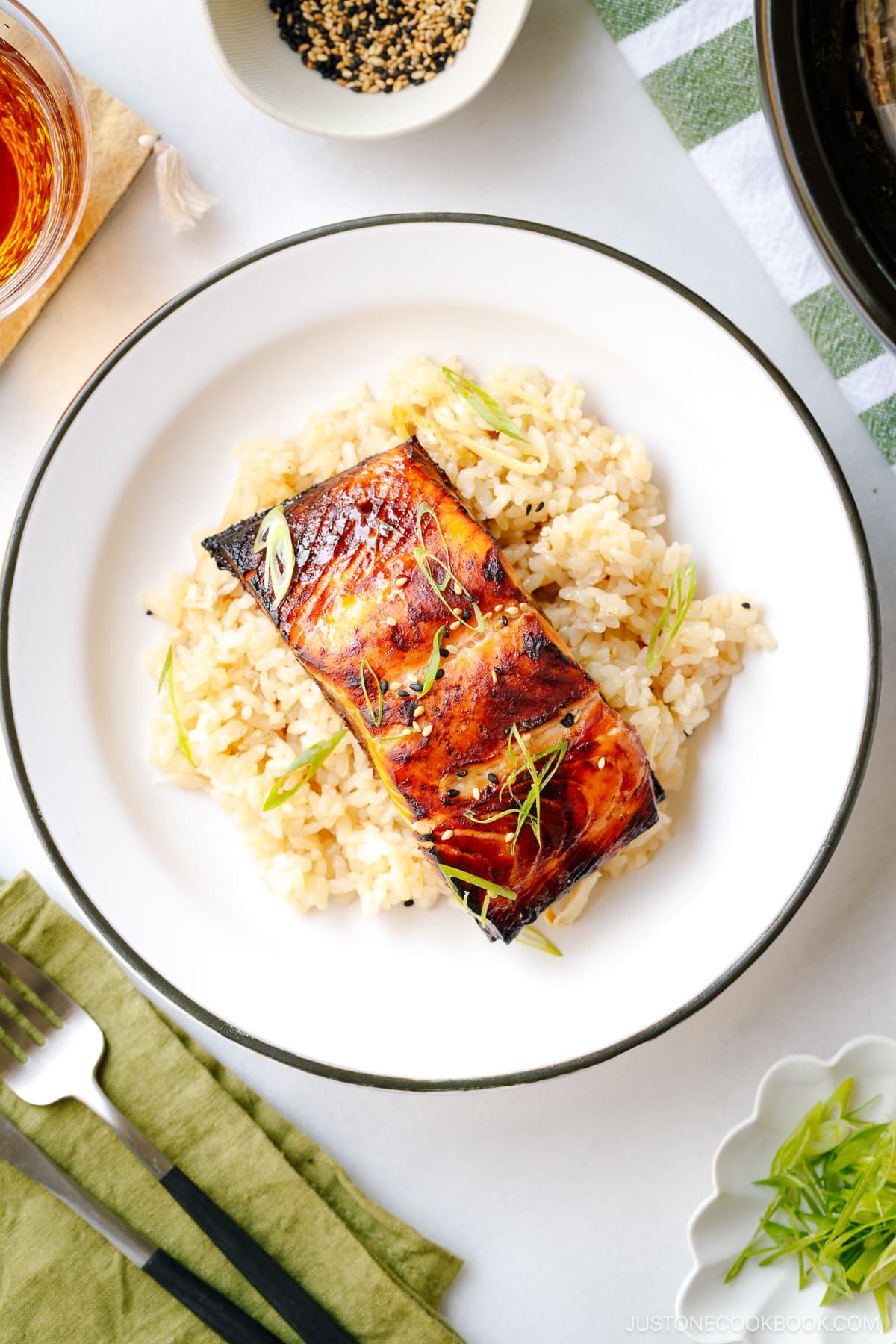

Ingredients for Miso Salmon
- Salmon: I recommend using salmon that is less than 1 inch (2.5 cm) thick for broiling. If you don’t have a broiler, wild King/Chinook salmon, which is thick and has a high-fat content, is ideal for baking. You don’t have to worry about the fish drying out quickly. Farmed Atlantic salmon, while very rare to find in the wild, is a more affordable and accessible option.
- Miso: I use white miso (shiro miso) in this recipe for two reasons. First, it is widely available in Japanese and Asian markets, as well as mainstream grocery stores. Second, the flavor profile complements this recipe well. If you have other types of miso, you can certainly use them (I use various miso for this recipe as well). Just remember that each brand and type of miso has a different level of saltiness, so adjust the amount accordingly.
- Soy sauce: I use organic kikkoman soy sauce. Please note that Chinese and Korean soy sauces have slightly different tastes.If you plan to cook more Japanese food, consider getting Japanese soy sauce.
- Sake: I use a $5-8 drinking sake and do not use a cooking sake that contains other ingredients, like salt. Sake is an important ingredient in Japanese cooking (read why it’s important here). If you don’t have it at the moment, use Chinese rice wine or dry sherry.
- Mirin: Just like sake, mirin is another important condiment for Japanese cooking. More about it in this post.
- Roasted sesame oil: We just need a tiny bit for the aroma.
- Garnish: Toasted black and white sesame seeds, and chopped green onion.
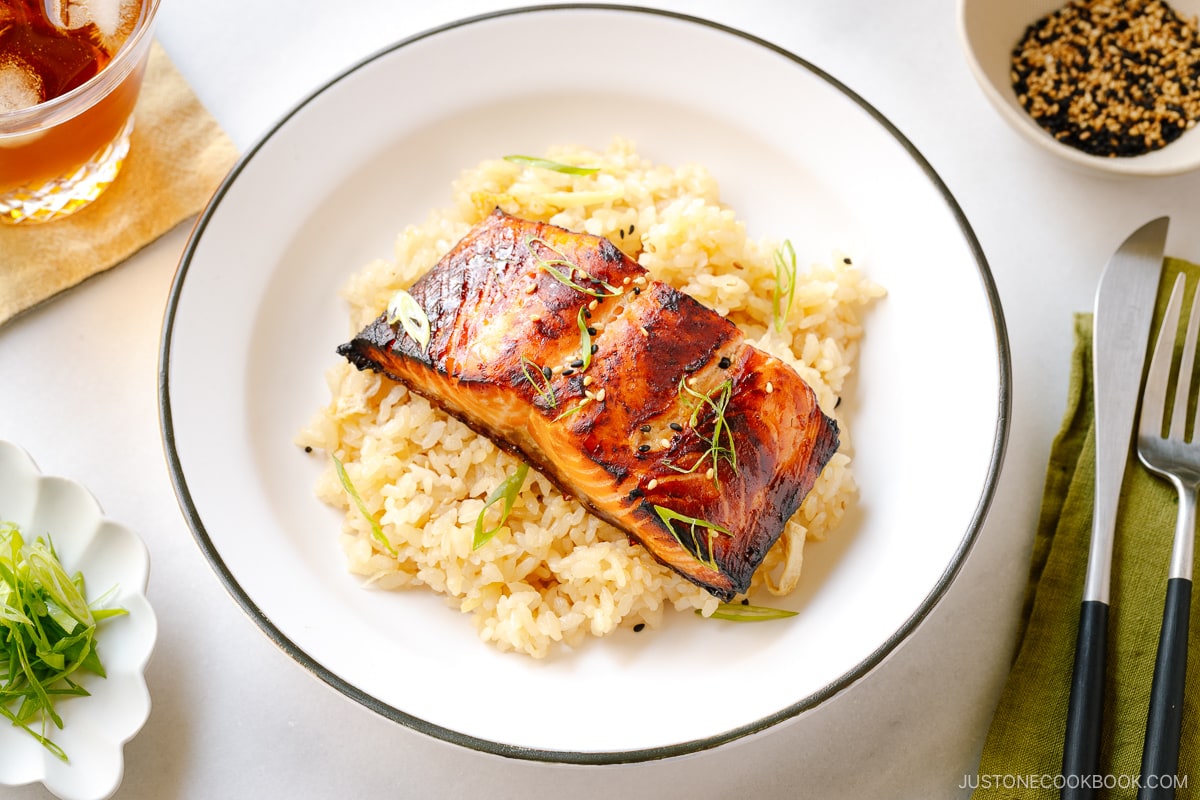
How to Make Miso Salmon
- Make the miso marinade and marinate the salmon for 1-2 hours.
- Remove the marinade from the salmon and broil it.
- Serve and enjoy!
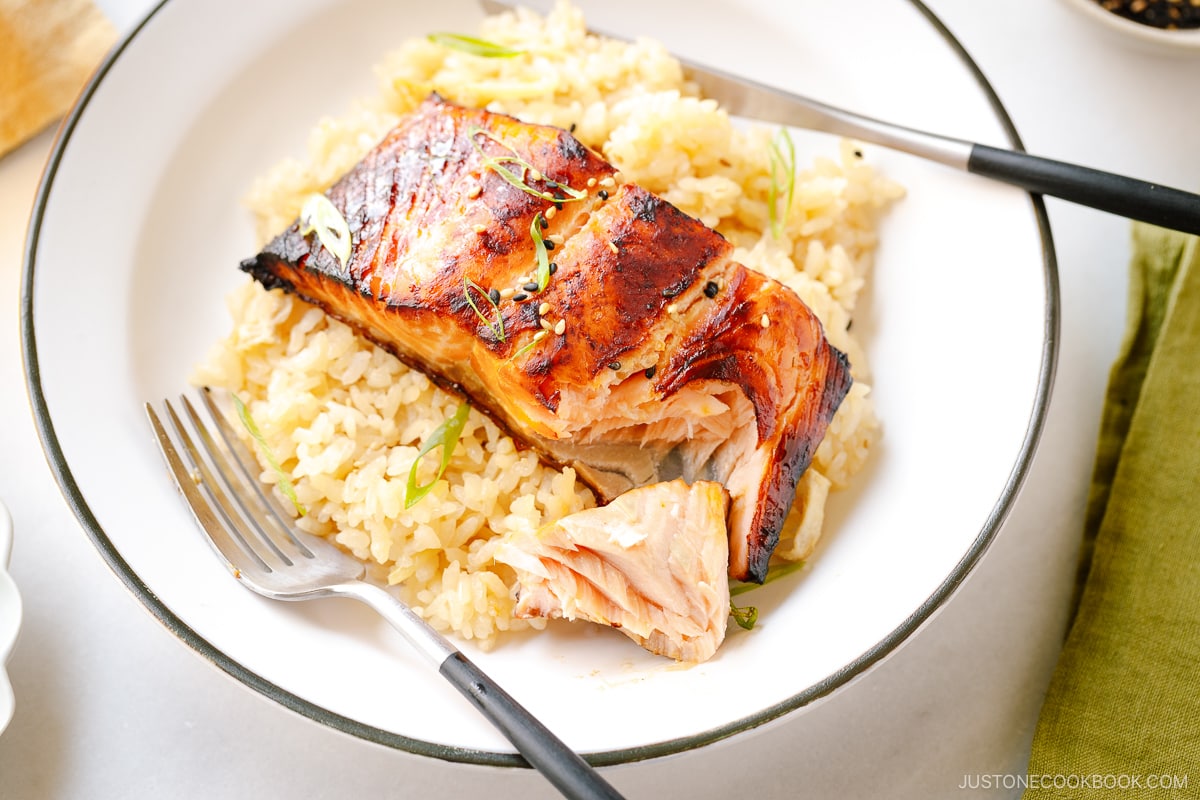
Nami’s Recipe Tips
- Use skin-on salmon. Don’t remove the skin. It will prevent the flesh from overcooking and drying out. You don’t have to eat it, but keep it on!
- Choose center-cut fillets about 1 inch (2.5 cm) thick, with each piece roughly the same size (around 6 oz / 170 g). After marinating in the fridge, broil for 10–13 minutes.
- Remove small bones and scales from the skin before marinating. This would make your dinner more enjoyable.
- Cut the salmon into individual fillets. Smaller fillets marinate and cook quickly!
- Marinate 1–2 hours for fillets under 1 inch (2.5 cm) thick and up to 3 hours for thicker cuts. Avoid overnight marinating, as miso is quite salty.
- Remove all the miso marinade before cooking because miso is prone to burning. For a glaze, simmer the leftover marinade with a little water, then drizzle it over the cooked salmon.
- Line a baking sheet with aluminum foil (not parchment, which can burn under the broiler). Lightly oil the foil to keep the skin from sticking.
- Place the oven rack in the center, about 9 inches (23 cm) from the top heating element, and set the broiler to high (550ºF / 290ºC).
- Control broiling by adjusting the rack distance between the food and the heat source. Unlike baking, you can’t set the oven temperature. Think of it like using hotter and cooler zones on a grill.
- The salmon is done when it flakes easily or the internal temperature reaches 125–130ºF (52–54ºC).
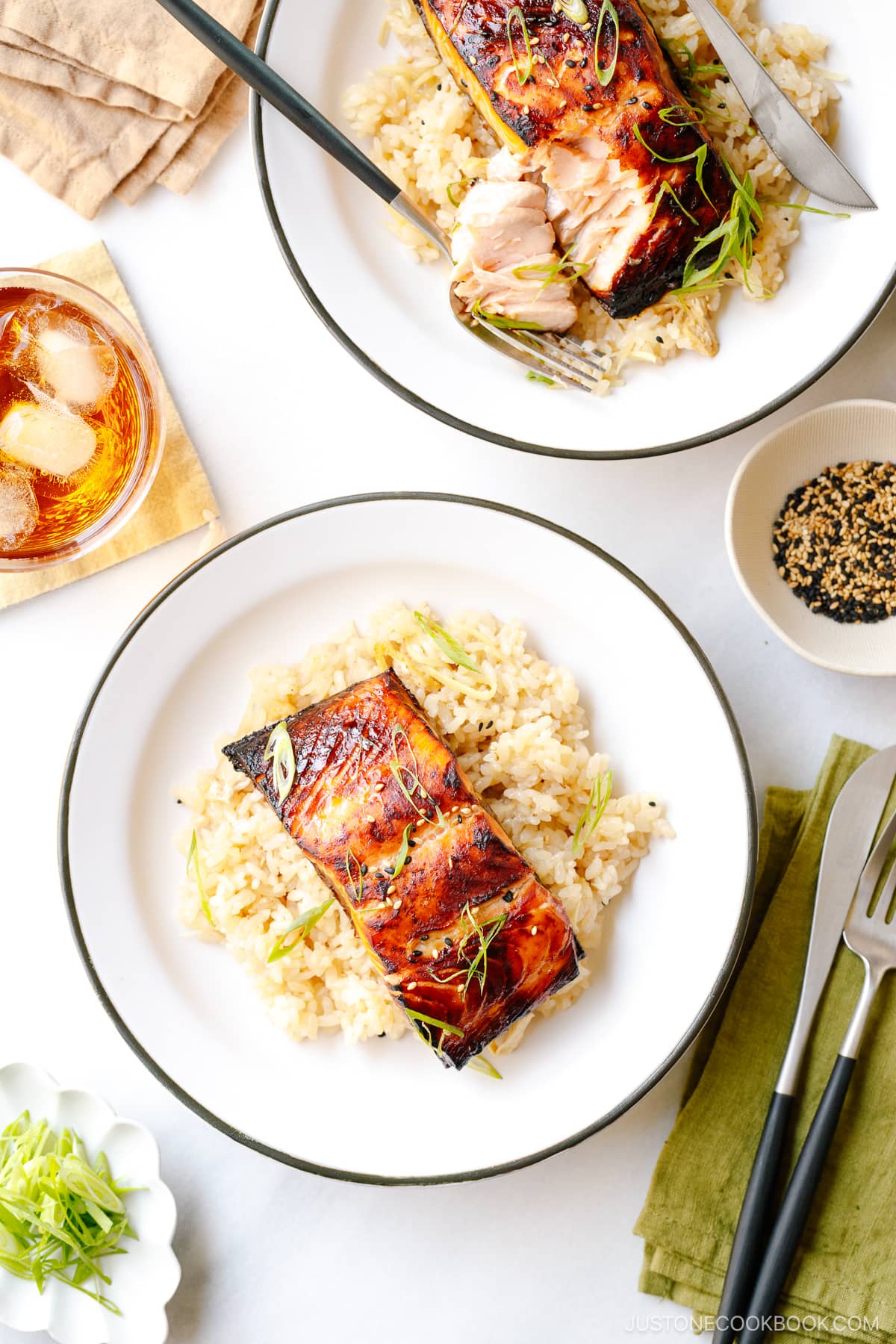
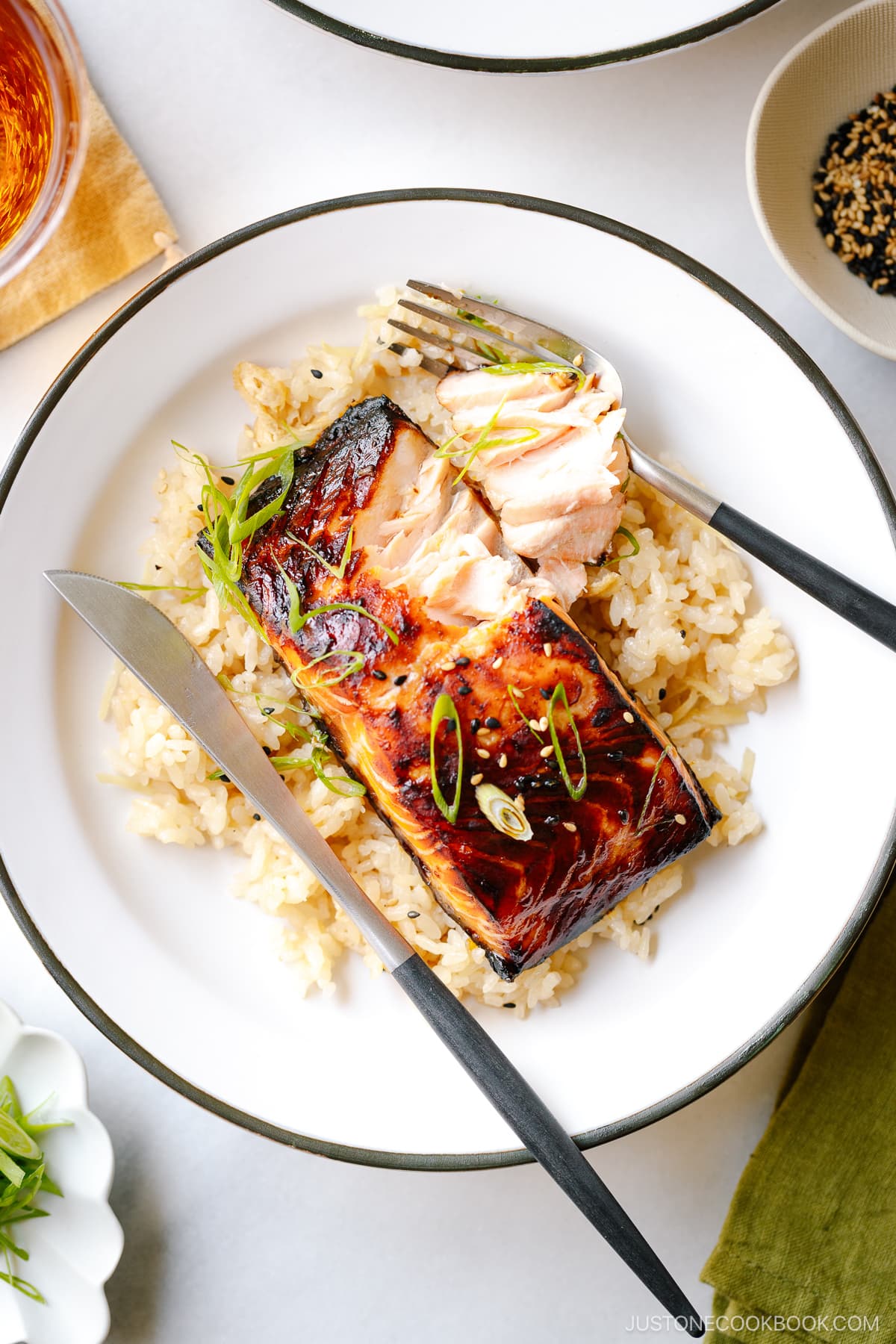
Why Broil the Salmon?
If you usually bake salmon, try broiling instead!
- Broiling cooks the salmon quickly with high heat from above, caramelizing the surface for a golden finish while keeping the inside juicy and tender.
- Baking uses gentler, all-around heat, which takes longer to cook, dries out the fish, and doesn’t give you that same lightly charred look and flavor.
Broiling vs. Baking Fish
In case you’re curious, I summarized the differences between broiling and baking fish, and which types of fish are suitable for broiling versus baking.
Broiling Method
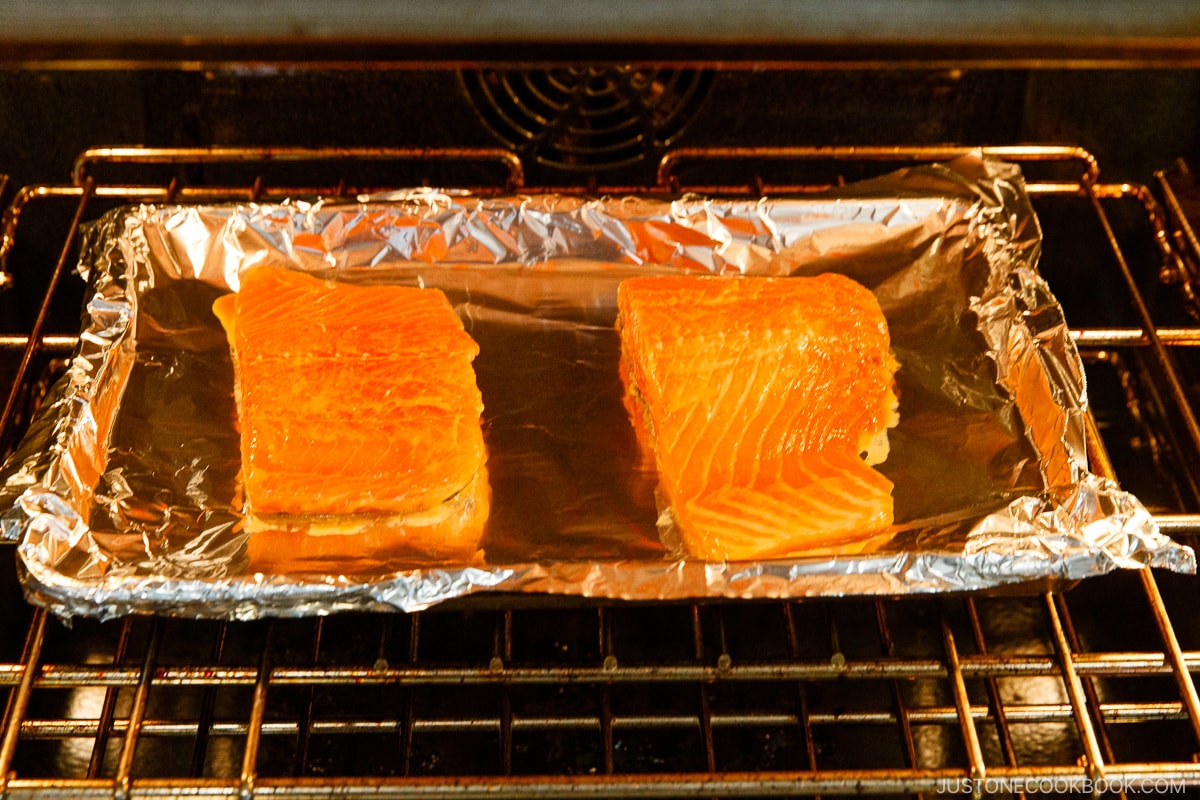
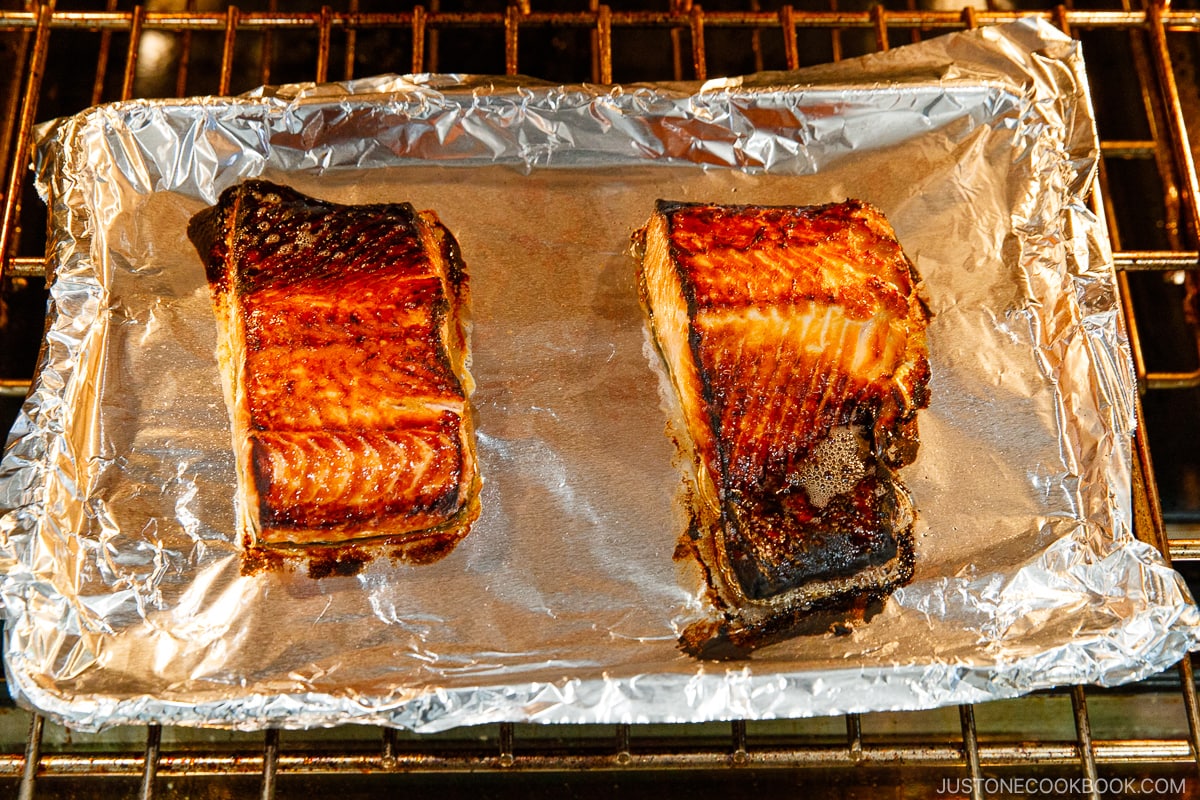
Broiling cooks the food from the direct radiant heat (infrared energy) coming from the oven’s top element. You control the cooking by adjusting the rack distance (how close the food is to the broiler) rather than the oven temperature.
Pros and cons:
- Delivers quick, high heat directly to the food’s surface
- Great for browning and caramelization
- Ideal for thin cuts of fish; thicker cuts won’t cook evenly
Best fish for broiling:
- Fatty fish: Salmon (thin cuts; under 1 inch or 2.5 cm), mackerel, swordfish
- Moderately lean fish: Cod, haddock (brushed with oil first)
- Thin fillets: Common in Japanese markets, where fish is often cut very thin
Baking Method
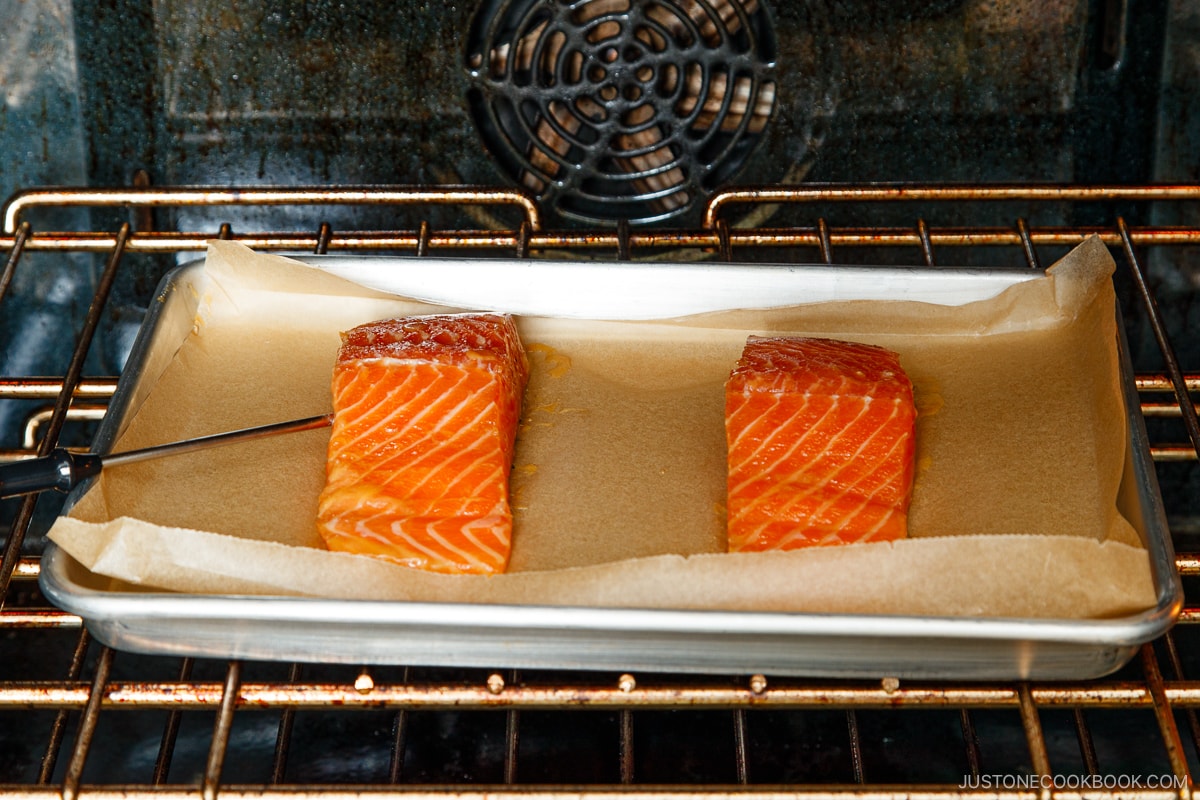
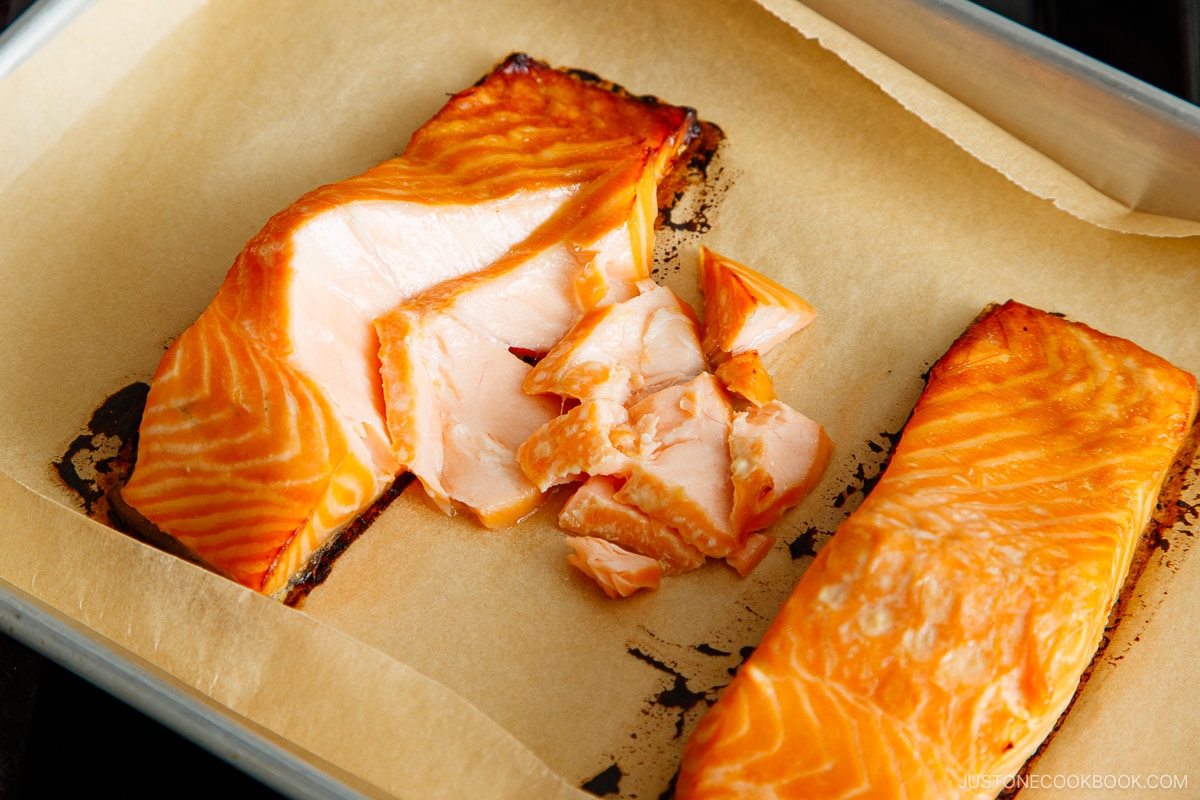
Baking cooks food by circulating hot air evenly throughout the oven, usually generated from the bottom heating element. You control the cooking by setting the oven temperature and placing the rack where you want the heat to reach most evenly.
Pros and cons:
- Steady, gentler heat cooks food more slowly and thoroughly
- Ideal for even heating and cooking of thick cuts of fish
- Dry heat means the food’s surface can become a bit dry
Best fish for baking:
- Fatty fish: Salmon (thick, fatty cuts), mackerel, swordfish
- Whole fish
- Thick and large fillets
- Lean, delicate fish like sole
Useful Kitchen Tools
The best method is to use a meat probe thermometer (that comes with your oven) or an instant-read thermometer, especially when the salmon fillets are very thick. With the right tool, you don’t need to guess if the salmon is cooked to the right temperature: It’s perfect every single time.
- A probe thermometer allows you to track the temperature of your chicken, turkey, salmon, etc., in the oven as they cook, so you don’t have to repeatedly open the oven door to test.
- An instant-read thermometer is a lot more versatile. You can check the temperature of your deep-frying oil and pan-fried fish or steak.
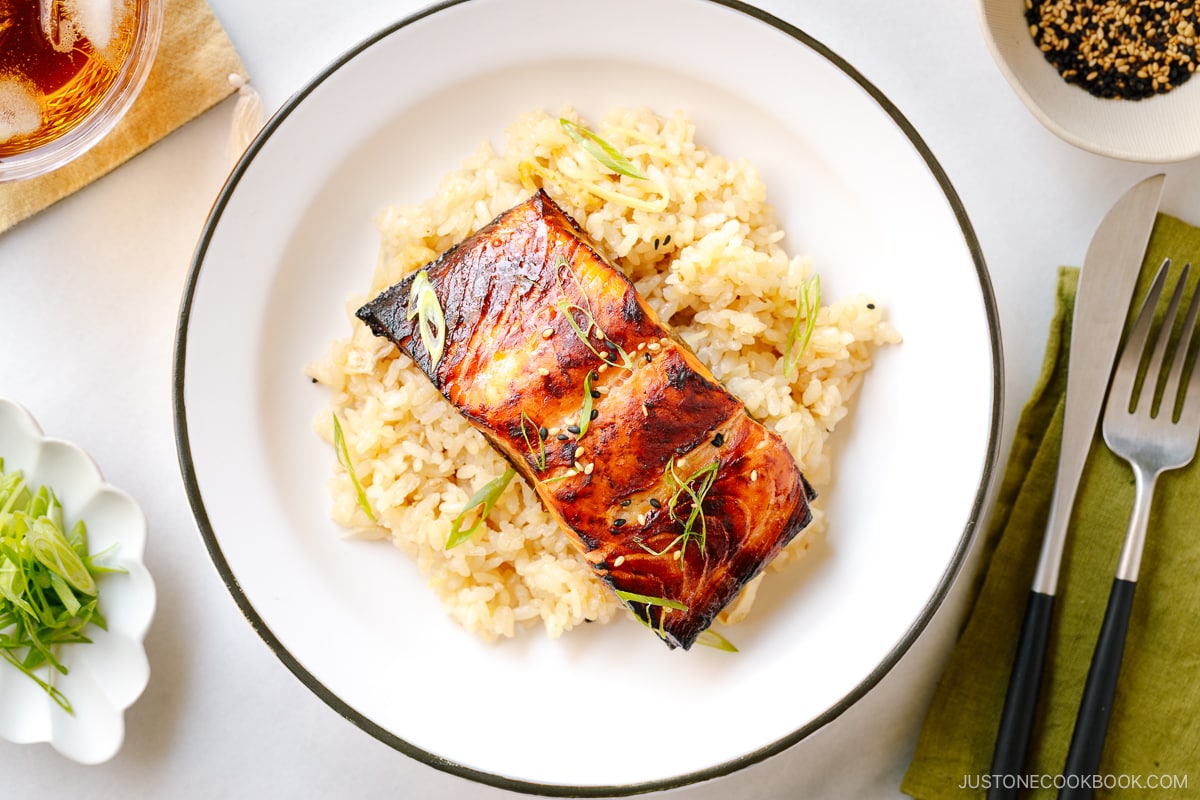
What to Serve with Miso Salmon
The rich flavor of miso-marinated salmon is lovely when matched with the aromatic ginger-infused rice.
- Rice: Ginger Rice
- Soup: Kakitamajiru (Japanese Egg Drop Soup)
- Sides: Kinpira Gobo
- Salads: Spinach Gomaae (Japanese Spinach Salad)
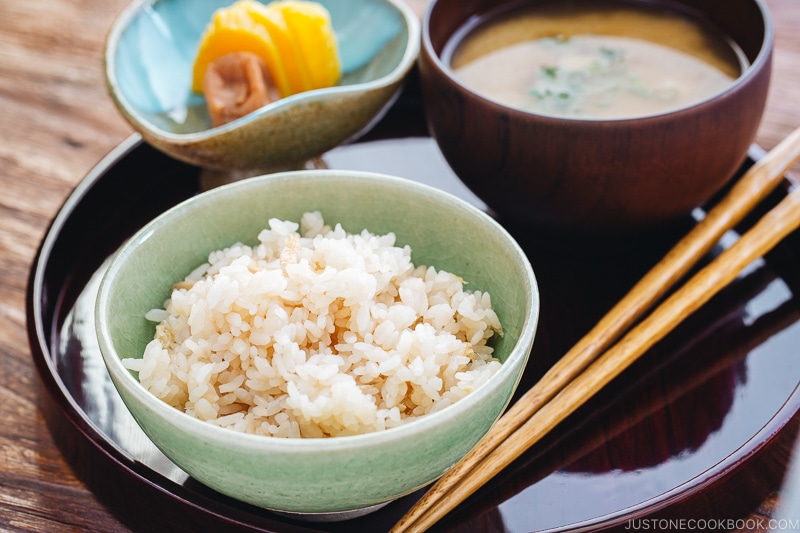
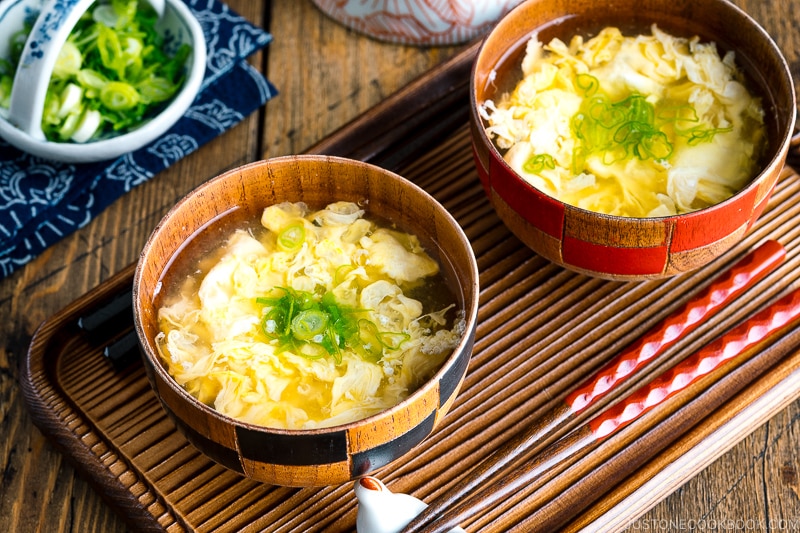
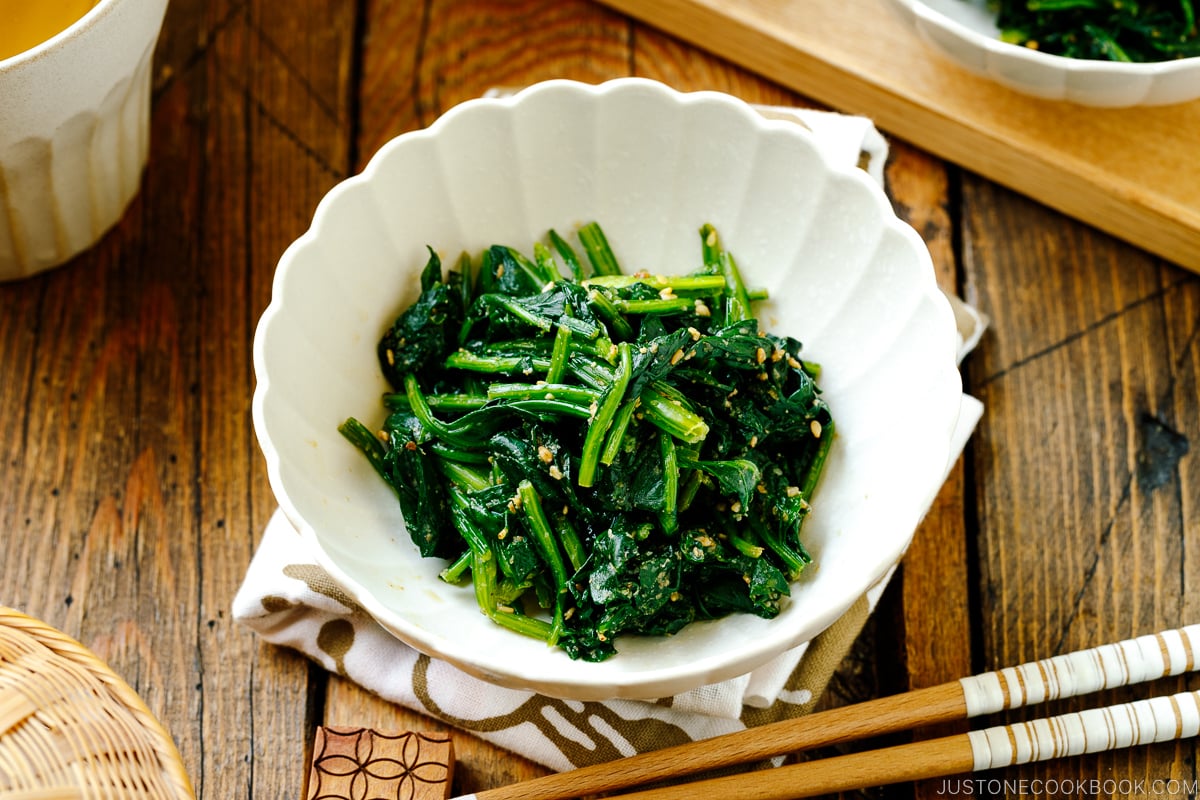
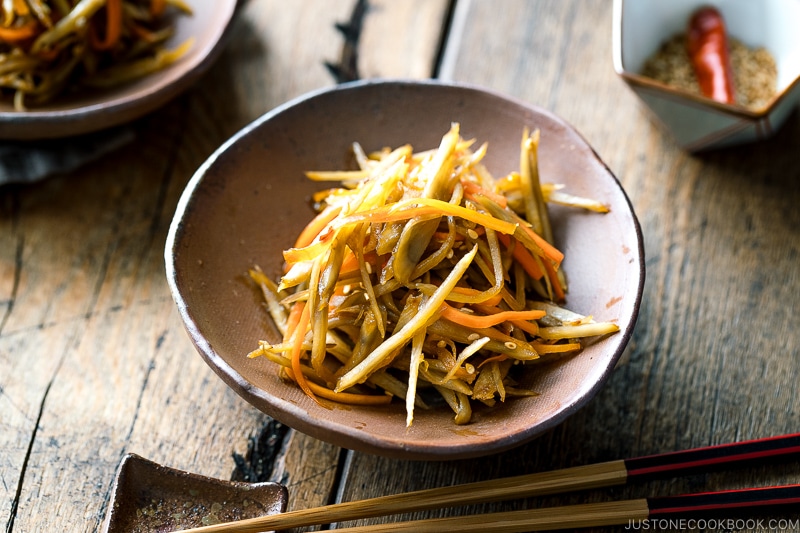
Storage and Reheating Tips
To Store: Keep leftover miso salmon in an airtight container in the refrigerator for up to 3 days.
To Freeze: Place in an airtight container and freeze up to 1 month. Thaw overnight in the fridge before reheating.
To Reheat: Cover with a moist paper towel and warm gently in the oven at 300ºF (150ºC) until heated through. Avoid the microwave—it can dry out the fish and make the texture rubbery.
Frequently Asked Questions
The USDA recommends cooking fish to an internal temperature of 145°F (63ºC); however, the remaining heat will continue to cook the salmon, resulting in well-overcooked fish. There are many discussions online on this topic, and many reputable cooking websites do recommend cooking the salmon to 120-130ºF (49-54ºC).
Miso is quite salty, so I don’t recommend marinating the salmon overnight, especially if the fillet is thin. Also, to marinate the salmon evenly, I recommend cutting a one-pound salmon fillet into two to four pieces. I recommend at least one to two hours. If you feel it’s not flavorful enough, please adjust it to your liking.
You can tell when salmon is cooked when its flesh turns translucent to opaque and flakes easily with a fork, chopsticks, or by pressing on the fish.
If the fish looks dry, you’ve probably cooked it too long. When salmon is overcooked, you may notice white protein (known as albumin) coming from the fish. While you can’t undo it, the salmon is still edible, albeit a little dry.
The broiling time depends entirely on your broiler’s settings, the distance of the rack from the heating element, and the thickness of the salmon fillets.
When I buy salmon fillets, I always opt for skin-on, center-cut fillets that are less than 1 inch (2.5 cm) thick. And make sure all the fillets are of the same thickness, each weighing roughly 6 ounces (170 g). After marinating the salmon in the refrigerator, it takes 10-13 minutes to broil.
Miso Salmon
Ingredients
- 2 skin-on salmon fillets (¾ lb, 340 g; ideally, less than 1 inch or 2.5 cm thick; 4–6 oz or 113–170 g per fillet)
For the Marinade
- 2 Tbsp miso (use any type of miso; I used Hikari Miso Organic White Miso)
- 1 Tbsp sake
- 1 Tbsp mirin
- 1 Tbsp soy sauce
- ¼ tsp toasted sesame oil
For the Garnish (optional)
- ½ tsp toasted white and black sesame seeds
- 1 green onion/scallion (chopped)
Instructions
- Before You Start: Please note that this recipe requires a marination time of 1–2 hours.
- Gather all the ingredients. Check your 2 skin-on salmon fillets for scales and tiny bones. To find bones, run your fingers along the flesh and sides, then pull them out with fish boning tweezers. To check for scales, run your fingers over the fish skin and scrape them off with the flat edge of a knife.
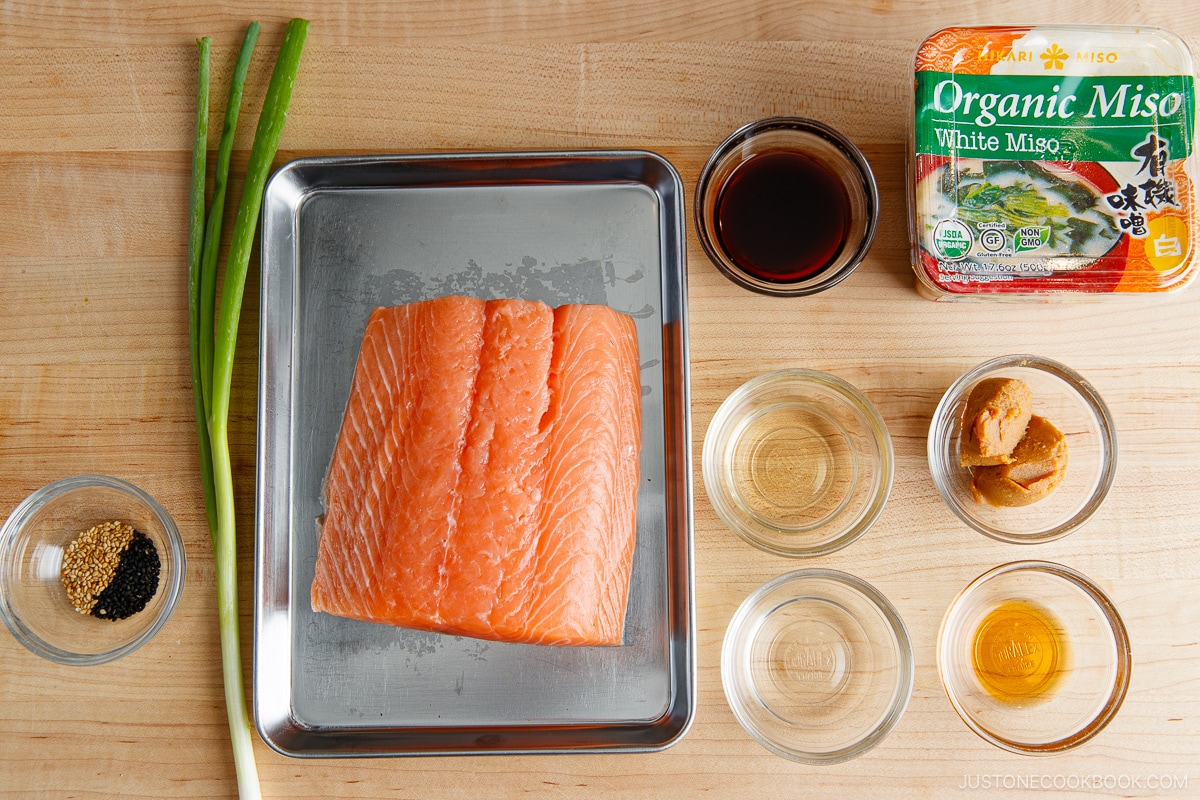
To Lightly Marinate
- In a large bowl or flat tray, mix the marinade ingredients: 2 Tbsp miso, 1 Tbsp sake, 1 Tbsp mirin, 1 Tbsp soy sauce, and ¼ tsp toasted sesame oil.
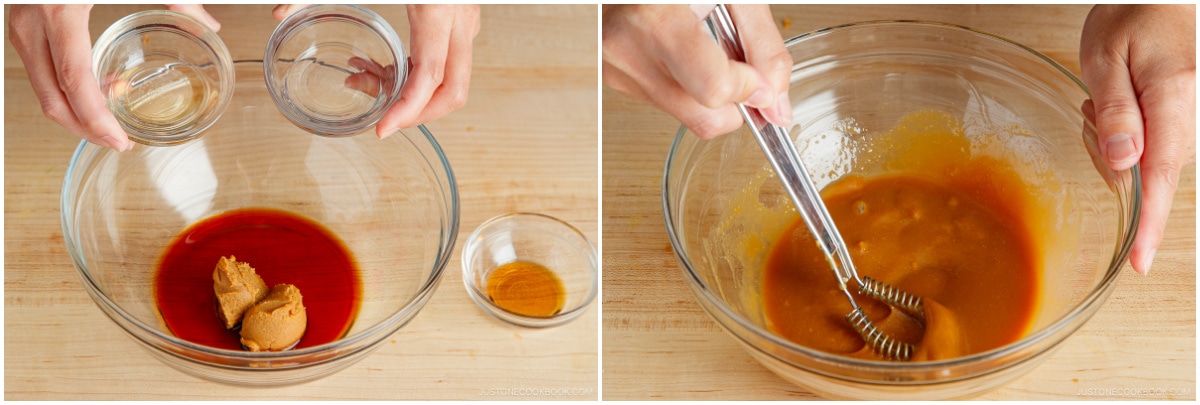
- If your salmon isn’t cut into fillets, slice it into individual portions (about 6 oz / 170 g each) for quicker, more even cooking. Place the pieces in the marinade, skin side up.
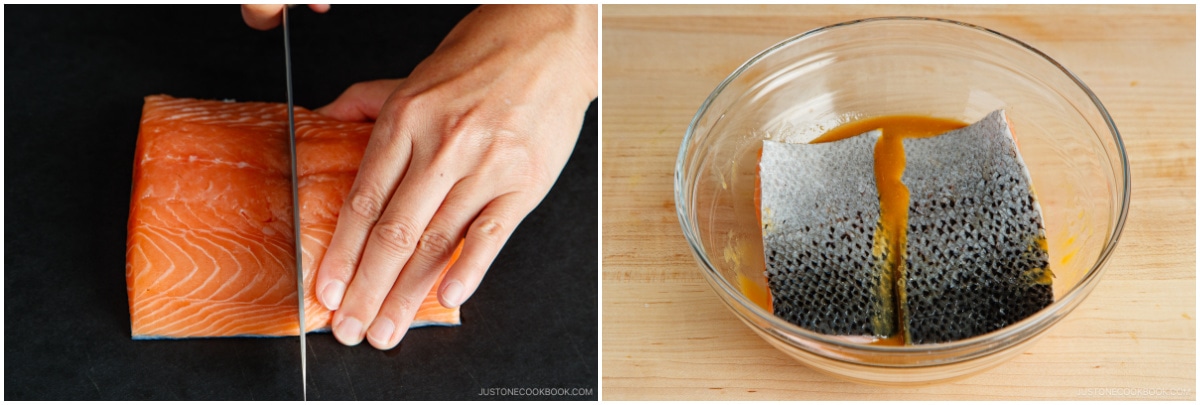
- Spoon the marinade over the salmon, coating the flesh, sides, and skin. Cover and refrigerate for 1–2 hours for fillets up to 1 inch (2.5 cm) thick, or up to 3 hours for thicker cuts.Nami's Tip: Avoid marinating overnight, as the miso marinade is too salty.
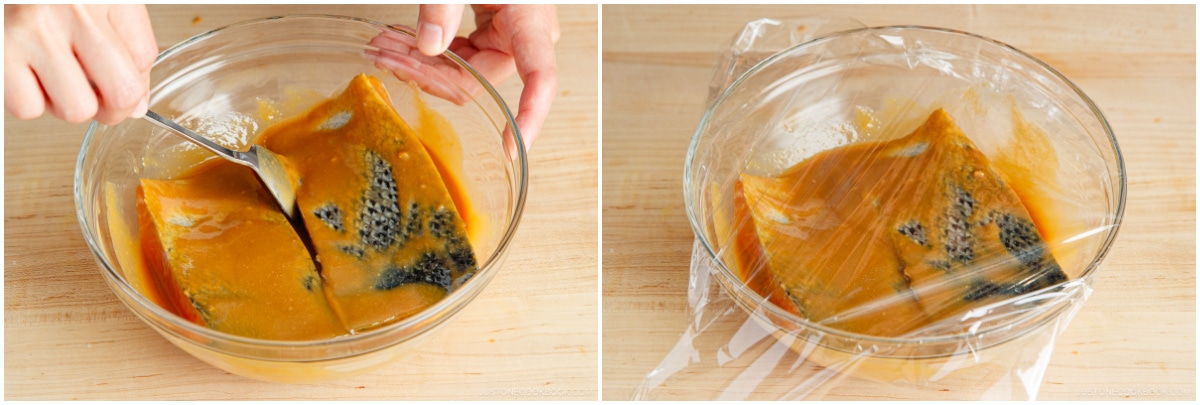
To Broil
- PREHEAT: Turn the broiler to High (550ºF/290ºC) and place a rack in the center, 9 inches (23 cm) from the top heating element. Preheat for 5 minutes. Nami's Tip: When broiling, you don‘t adjust the oven temperature; instead, you control the cooking by adjusting the rack distance (how close the food is to the broiler). Think of it like using hotter and cooler zones on a grill.
- Cut the green onions diagonally into thin slices. Line a baking sheet with aluminum foil (since parchment paper will burn) and spray or brush the oil so the salmon skin won‘t stick.
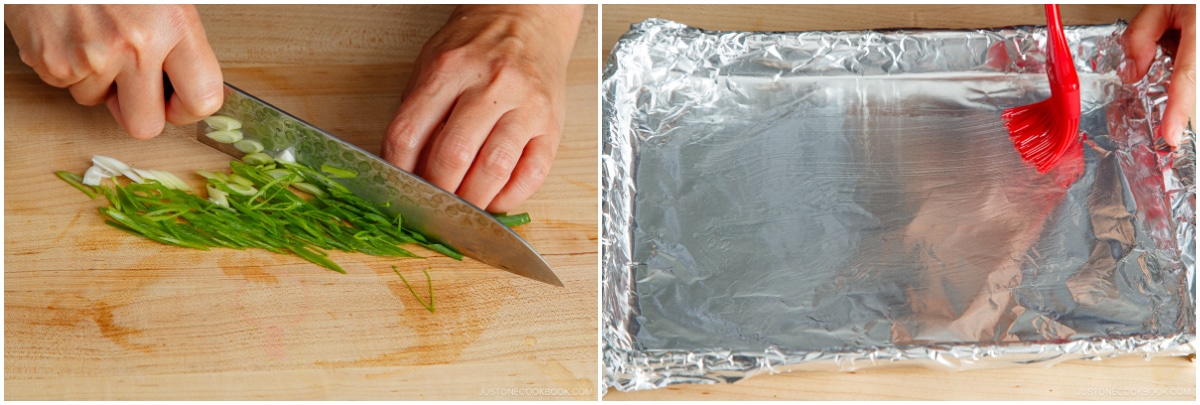
- Remove all excess marinade before broiling, as miso burns easily.
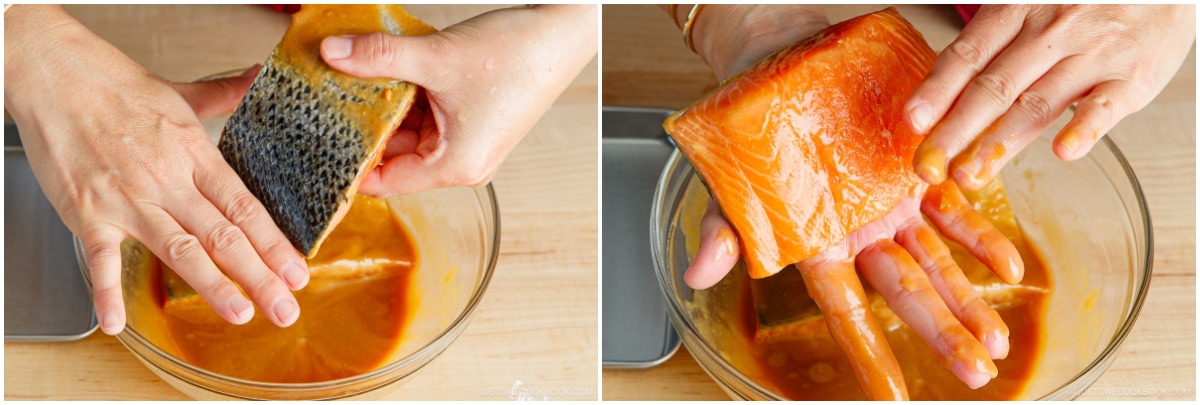
- Nami's Tip: I like to scrape off the excess marinade from all sides with an offset spatula or butter knife.Place the salmon skin side down on the prepared baking sheet.
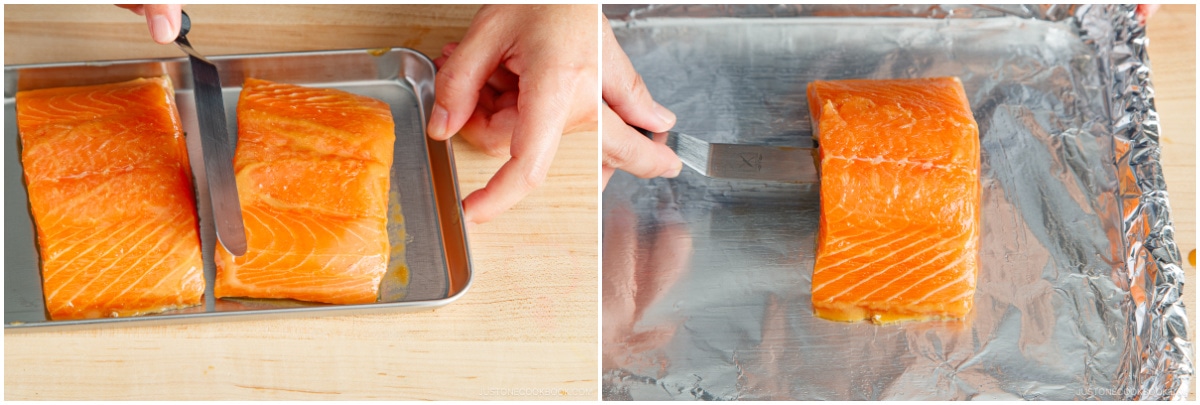
- Broil the salmon for about 10–13 minutes or until the thickest part of the fillet reaches 125–130°F (52–54ºC). No need to flip the salmon. For medium-rare, stop cooking at 120ºF (49ºC). Note: The USDA recommends cooking fish to 145°F (63ºC). Keep in mind that the salmon continues to cook with residual heat, which may cause it to overcook. I highly recommend a Thermapen instant-read thermometer to check the temperature.
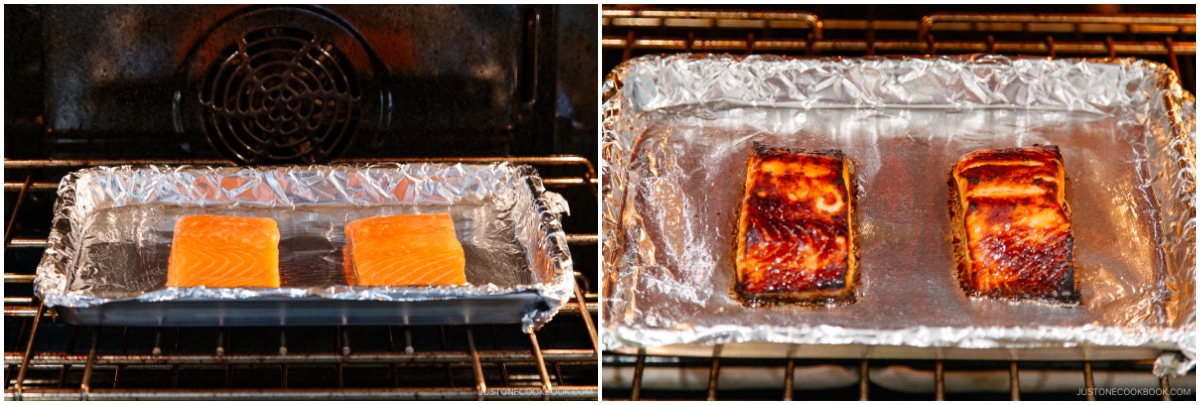
To Bake
- PREHEAT: Preheat the oven to 425°F (220ºC) with a rack placed in the center position. For a convection oven, reduce the cooking temperature by 25ºF (15ºC). Line a baking sheet with parchment paper.
- Remove all excess marinade before broiling, as miso burns easily. Nami's Tip: I like to scrape off the excess marinade from all sides with an offset spatula or butter knife.
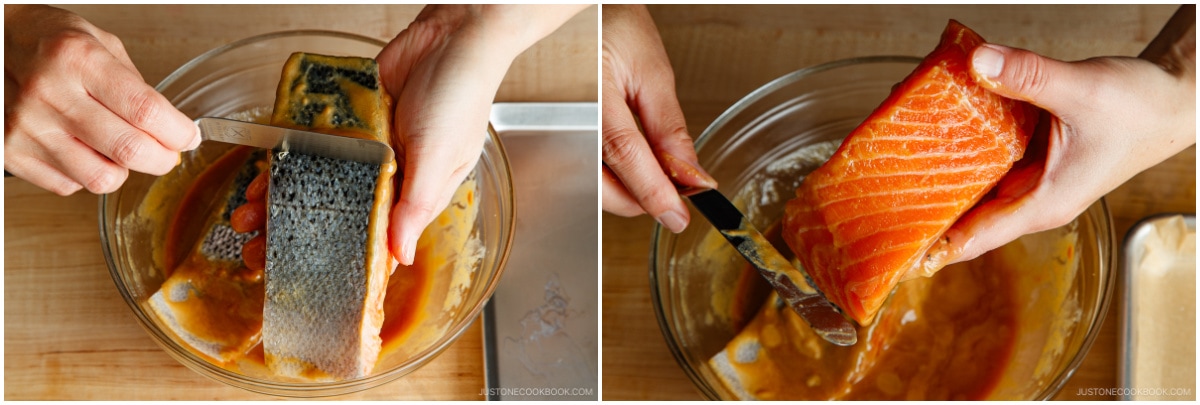
- Place the salmon skin side down on the prepared baking sheet. If using an oven probe, insert it into the thickest part of the fillet.Nami's Tip: If you don‘t have a probe, I highly recommend a Thermapen instant-read thermometer.
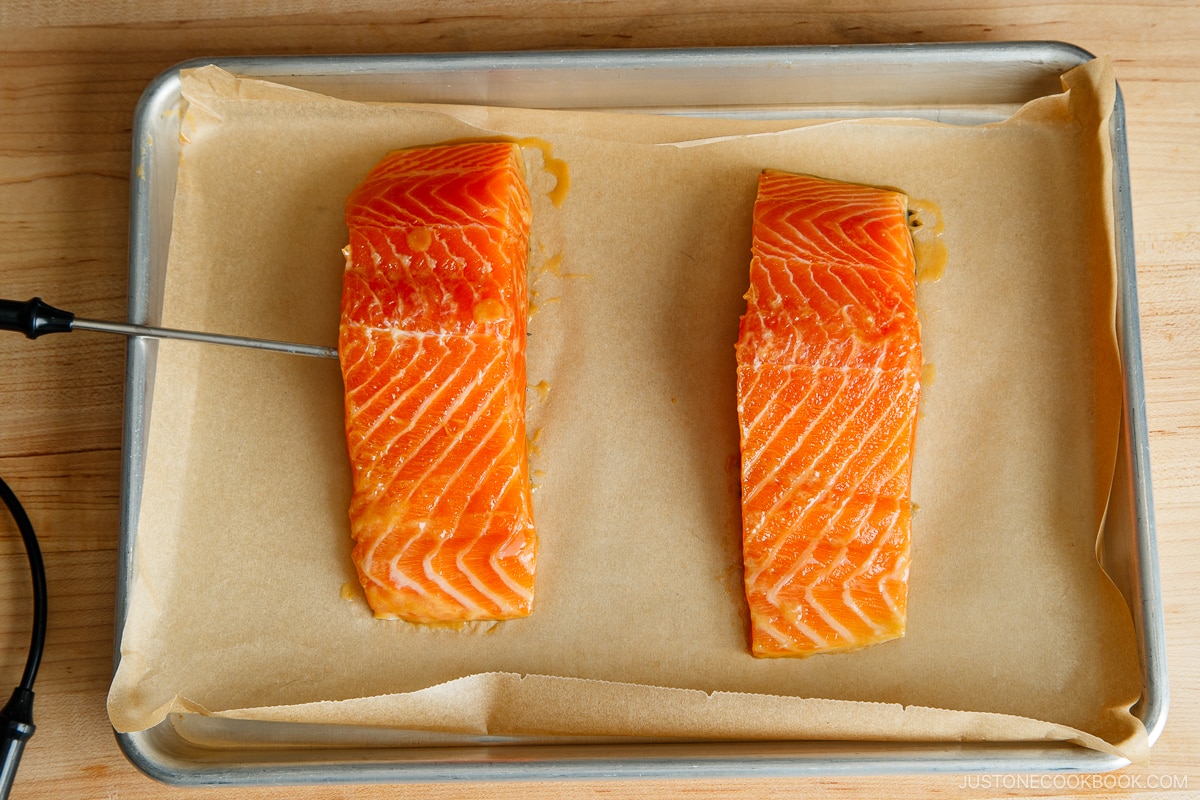
- Bake the salmon for about 18–20 minutes, or until the thickest part of the fillet reaches 125–130°F (52–54ºC). No need to flip the salmon. For medium-rare, stop cooking at 120ºF (49ºC). Nami's Tip: Bake about 5 minutes per ½-inch (1.3-cm) of thickness, measured at the thickest part. Note: The USDA recommends cooking fish to 145°F (63ºC). Keep in mind that the salmon continues to cook with residual heat, which may cause it to overcook.
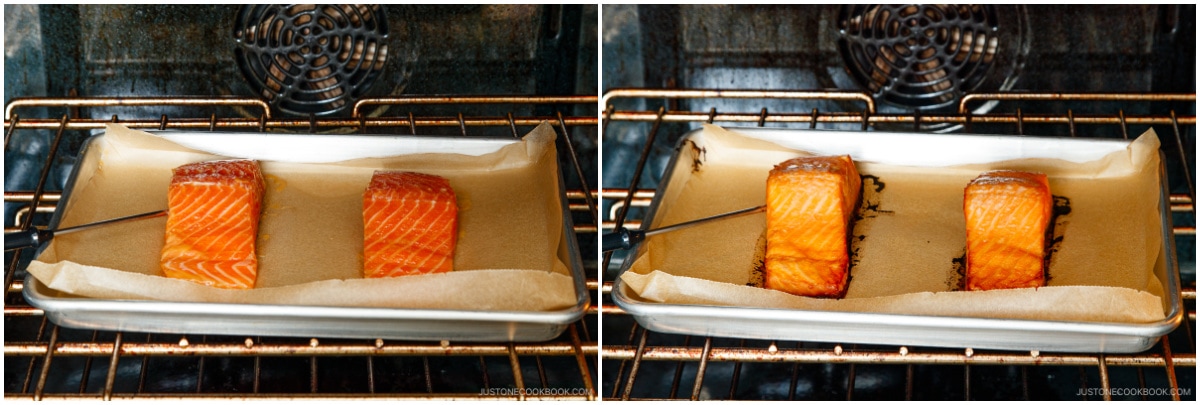
- Remove the salmon from the oven and check doneness by flaking the flesh—it’s ready if it flakes easily.Optional char: For a golden, slightly blistered finish, underbake the salmon a little, then remove the probe and switch to broil on High (550ºF/290ºC). Keep the rack in the center and broil for about 3 minutes, until the surface is browned. Remember, the salmon will continue to cook while broiling, so switch early to avoid overcooking.
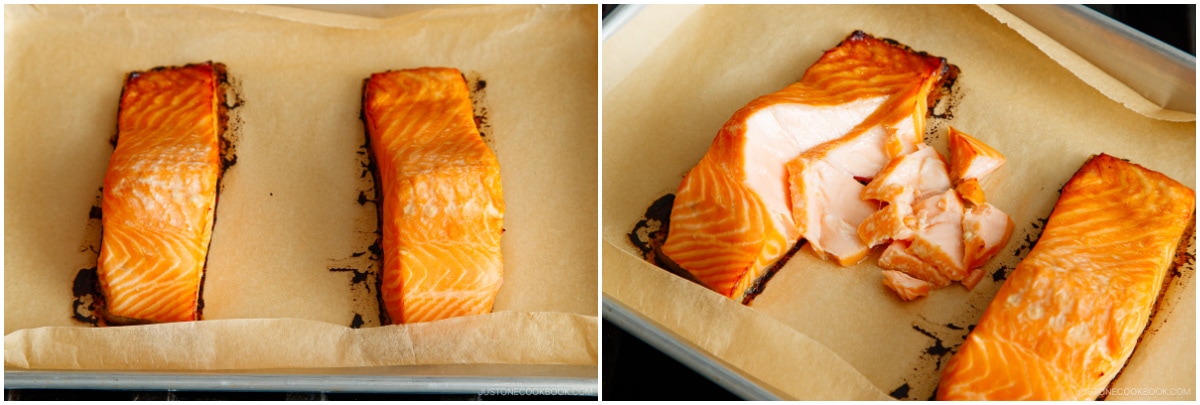
To Serve
- Serve the Miso Salmon and top with ½ tsp toasted white and black sesame seeds and 1 green onion/scallion thinly sliced (both toppings are optional). I like to serve this salmon with Ginger Rice. Enjoy!
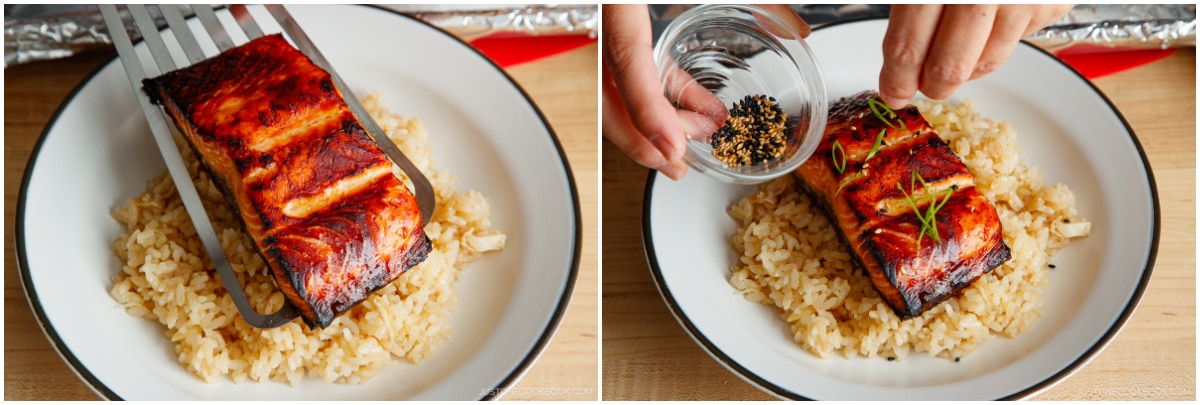
- Optional glaze: I usually discard the marinade (which is why I keep it to a minimal amount). But if you’d like a glaze, dilute the marinade with a little water and simmer for a few minutes. Drizzle it over the salmon or save it for another dish.
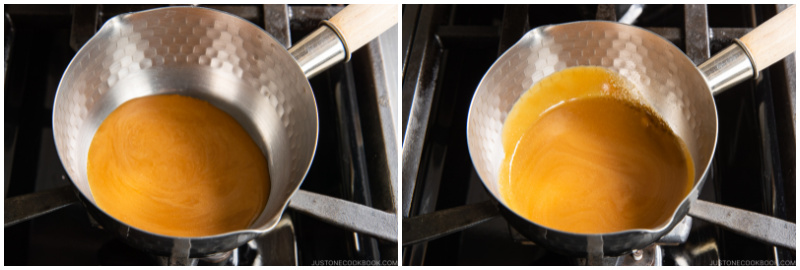
To Store
- You can store the leftovers in an airtight container and store in the refrigerator for up to 3 days and in the freezer for a month.
Nutrition
Did you make this recipe?
Tag @justonecookbook on Instagram so we can see your delicious creation!
Editor’s Note: This post was originally published on September 2, 2014. The post has been updated with revised, clear instructions (still the same recipe) with new step-by-step pictures, final photos, and video on November 17, 2023.



